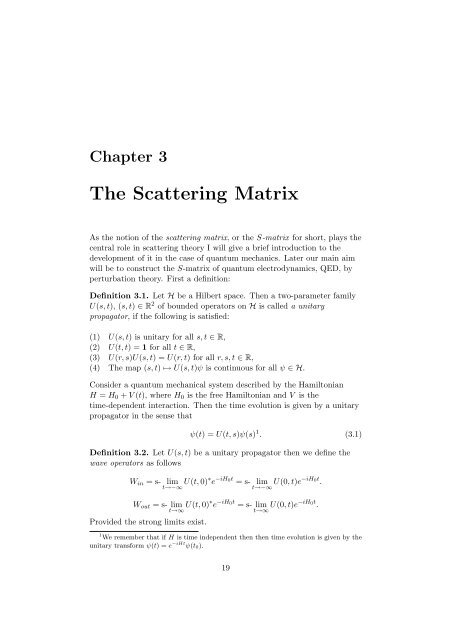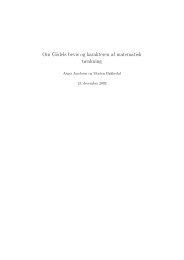Master Dissertation
Master Dissertation
Master Dissertation
Create successful ePaper yourself
Turn your PDF publications into a flip-book with our unique Google optimized e-Paper software.
Chapter 3<br />
The Scattering Matrix<br />
As the notion of the scattering matrix, or the S-matrix for short, plays the<br />
central role in scattering theory I will give a brief introduction to the<br />
development of it in the case of quantum mechanics. Later our main aim<br />
will be to construct the S-matrix of quantum electrodynamics, QED, by<br />
perturbation theory. First a definition:<br />
Definition 3.1. Let H be a Hilbert space. Then a two-parameter family<br />
U(s, t), (s, t) ∈ R 2 of bounded operators on H is called a unitary<br />
propagator, if the following is satisfied:<br />
(1) U(s, t) is unitary for all s, t ∈ R,<br />
(2) U(t, t) = 1 for all t ∈ R,<br />
(3) U(r, s)U(s, t) = U(r, t) for all r, s, t ∈ R,<br />
(4) The map (s, t) ↦→ U(s, t)ψ is continuous for all ψ ∈ H.<br />
Consider a quantum mechanical system described by the Hamiltonian<br />
H = H0 + V (t), where H0 is the free Hamiltonian and V is the<br />
time-dependent interaction. Then the time evolution is given by a unitary<br />
propagator in the sense that<br />
ψ(t) = U(t, s)ψ(s) 1 . (3.1)<br />
Definition 3.2. Let U(s, t) be a unitary propagator then we define the<br />
wave operators as follows<br />
Win = s- lim<br />
t→−∞ U(t, 0)∗ e −iH0t = s- lim<br />
t→−∞ U(0, t)e−iH0t .<br />
Wout = s- lim<br />
t→∞ U(t, 0) ∗ e −iH0t = s- lim<br />
t→∞ U(0, t)e −iH0t .<br />
Provided the strong limits exist.<br />
1 We remember that if H is time independent then then time evolution is given by the<br />
unitary transform ψ(t) = e −iHt ψ(t0).<br />
19



